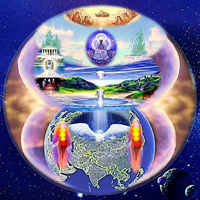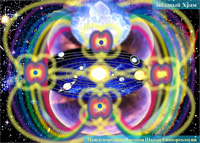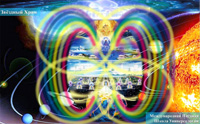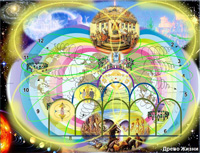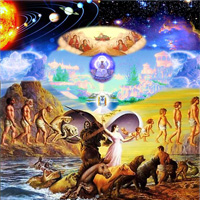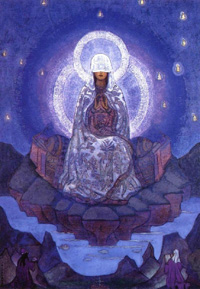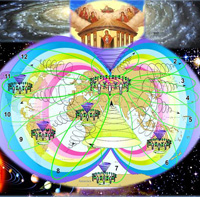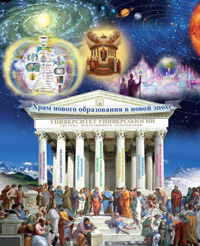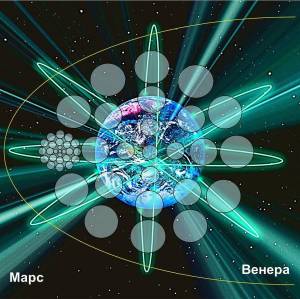Calendar
| Mo | Tu | We | Th | Fr | Sa | Su |
|---|---|---|---|---|---|---|
| 1 | 2 | 3 | 4 | |||
| 5 | 6 | 7 | 8 | 9 | 10 | 11 |
| 12 | 13 | 14 | 15 | 16 | 17 | 18 |
| 19 | 20 | 21 | 22 | 23 | 24 | 25 |
| 26 | 27 | 28 | 29 | 30 | 31 |
Moon Phase

Banners
| The law of cyclicity |
|
(The law of transforming quantity into quality)
Pesina Tatyana I., candidate of technical sciences.
The world is constantly moving and developing; it is cyclic by nature. This is how people breathe. This is how people’s hearts beat. This is how day replaces night. This is how seasons alternate. This is how civilizations are born, die, and reappear in a new capacity. There are small cycles, such as a heartbeat, and there are eons thousands of years long. The small cycles are embedded in the large ones, like in a nesting doll: each cycle is a part of a larger cycle; this goes on and on. The end of one cycle leads to the transformation of the life of the system, expansion of consciousness, and manifestation of the system in a new form of life, a new energy level. A development within cycles does not occur simultaneously as the duration of a cycle is different. Cyclical changes manifest as a continuous alternation of active and passive phases: involution and evolution. Ancient writings describe it as a descent of spirit into matter and ascent of spiritualized consciousness. In the involutional phase occurs the destruction of the imperfect: - destruction of obsolete forms of the old world - destruction of imperfect, conservative relations - destruction of dogmas and stereotypes of thinking Therefore, in the involutional phase occurs the destruction of all that is no longer capable of further evolutionary development that does not comply with the new goals of evolutionary development that does not develop itself, detains the development of others, and prevents the birth of the new. In the evolutionary phase, anything that was differentiated by appropriate levels in the involutional phase is prepared to unite in new, more advanced forms. Involution - development of a greater level of consciousness to a less advanced - from general to specific - division - destruction - differentiation - adaptation - analysis - conversion of energy (communication) to matter Evolution - the development of a lower level of consciousness to a more advanced - from the particular to the general - an association - creation - integration - synthesis - conversion of matter to energy (communication) Thus, according to the law of recurrence, any life system goes through two phases in the process of development: analysis and synthesis, involution and evolution. During this process a gradual, cyclical accumulation of experience in the unified field of intelligence of the universe occurs. Both phases are preeminent. Only the presence of both phases ensures a complete development, the fullness of accumulating experience in a cycle, and creating the conditions to begin developing a new cycle. This is the process of creating the conditions for a transition to quantitative accumulation to a new quality, a transition to a qualitatively new level, starting a new stage of the development spiral. It is important to formulate the law of cyclicity. The accumulation of experience is carried out cyclically. Cyclicity manifests in the alternation of two phases (involutionary and evolutionary), in twelve consecutive stages of forming the system. This allows the full accumulation of experience in the cycle and creates conditions for the transition of the system to a new level, where it learns the new value orientations and the purpose of the systems of the higher level. This marks the beginning of a new round of development of the spiral, including two new phases and twelve stages in the formation cycle. Why does the period of development of any life cycle of the system consist of twelve steps? The birth of the sevenfold structure has been considered (unity perceives itself through the dualism of polar sources; the interaction of polar bases gives birth to trinity which goes outward through the fourth (transitional) level when the threefold reason interacts with threefold effect; in this way a sevenfold structure is born as the seven steps in the development of life). - the formation of the seven-level structure in time occurs during the period of the system’s life cycle - according to the law of continuity and similarity during a gradual passage of involutionary and evolutionary phases at each level its own sub-cycle is formed - this is how seven sub-cycles are formed on both the involutionary and the evolutionary phases. Given that two sub-cycles are transitional, a cycle of twelve sub-cycles as twelve qualities of the system development in time occurs. - Einstein’s formula, binding mass and energy for the involutionary and evolutionary phases will look different - in the involutionary phase imperfect structural associations are broken, energy is converted into matter: m = Eb / c2. - in the evolutionary phase better structural associations between the elements are formed. As a result of a more effective interaction between the system elements, energy is released, matter is transformed into light: Eb = m x c2. The system becomes more structured and compact and the energy of the field increases. Thus, the unlimited development of the world takes place cyclically. Each cycle is designed to bring the life of the system to a new level of consciousness, to a higher stage of developmental spiral, to more advanced abilities to create a better world. It is important to examine how the law of recurrence reflects in philosophy, psychology, and other fields of science and life.
Heraclitus wrote about cycles in the 6th cent. B.C. He viewed the world as “eternal fire, once lighting and once fading.” According to V. Lenin, this phrase is a very good explanation of how dialectical materialism started. Heraclitus said that the world’s development is cyclical; in nature every creature and property turns into its opposite, cold things become warm, warm things become cold, etc. The philosophy of esotericism describes a cycle as the descent of spirit into matter and its rise to the point of beginning a descent, but in a new capacity of consciousness. The unity of spirit and matter, their interaction and their relativity are expressed in a popular statement: “matter is the lowest point in the descent of spirit (involution), but spirit is the highest point in the ascent of matter (evolution).” Both the Western and Eastern philosophies have their own characteristics, which essentially correspond to both phases of a united cycle of development. - the philosophy of the West is activity, analysis, differentiation, specialization, development of specific sciences, outgoing, but often with traces of isolation and loneliness - the philosophy of the East is the principle of non-interference, concessions, the principle of non-action, concentration on the inner world of man, “I am in everything and everything is in me” - the task of the present stage of development is to unite both philosophies, and based on universology to reach a new level of holistic worldview The ancient people perceived the world as a whole. The ancient thinkers had less information of the world, but they had better knowledge of the whole. Today, people know much more about the world, which is the information of details. It is time to go back to the general, to the unity, from analysis to synthesis. The practice of many scientific discoveries confirms the fact that “it takes a century of analysis and an ocean of facts for a minute of synthesis.” Humans have learned to analyze, endlessly separating the whole; they have already accumulated an ocean of facts and unrelated information. Yet, how often they lack a minute of synthesis! At present, the human mind has already approached the urgent necessity of synthesis. It is the time when all the accumulated information is being synthesized in order to make a qualitative leap in development.
The relationship of two phases of a united cycle is expressed in Kant’s postulate: “On the road to analytical knowledge, humans are unable to perceive the truth because they infinitely separate the existing unity. Only those on the road to synthesis are able to perceive the truth.” Reflection is the study “from the general to the particular”, the initial, analytical stage of the study from a common worldview to its division to structural elements (events, phenomena, concepts), to the study of their repetitive patterns. Transformation is the study “from the particular to the general,” the synthesizing stage of knowledge of the particular manifestation of the universal laws to the synthesis, uniting the known ideas to the new system of relations. This is a stage of managing systemic relationships aiming to direct them towards a more efficient development.
2. In a human body - the existence of biorhythms in the body (daily, monthly, seasonal, annual, and others) - sleep and wakefulness - biorhythm brain - reflex arc of the CNS - respiratory cycle - cardiac cycle - cyclical nature of the release of digestive juices - ovulatory cycle - the entering of all substances in the body and their elimination - biogeochemical cycles of metabolic processes in cells
3. In socio-economic sphere The Russian poet Gumilev studied cyclicality in the development of ethnic groups. After nucleation, ethnicity goes through the following phases: development, maturity, decline, and death. One ethnic group is replaced by another, which implements its own cycle. Kondratiev, Director of the Institute for Economics in Moscow, has researched the great economic waves and showed how the alternating ups and downs in economy occur.
4. In psychology Ever since Hippocrates (5th c. B.C.), the seven-year cycles of accumulation of human experience have been taken into account. At a certain stage of development, a child breaks toys and tears books, but while growing up, he or she learns to works with blocks, read and write books. K. Jung identified two basic psychological characteristics determined by the direction of human expression: extroversion and introversion. Extroversion (outward orientation): - external activities in the surrounding world - analyzing phase of consciousness - active study of the causal connections of events Introversion (towards the inside): - deep inner work - synthesizing phase of consciousness - qualitatively new systemic relationships are created on the basis of the learned ideas As for alternation of phases in the developmental cycle, their relative simultaneity should be noted, of which K. Jung wrote as of unilateral compensation: “Each type of expression has its own tendency to compensate for the unilateral quality of its type. The trend, which is biologically feasible, as it seeks to keep composure. Through compensation, secondary characters and types appear.” The process of reflection is followed by transformation, which N. Bernstein described as “anticipatory reflection” - the ability to anticipate or predict subsequent development based on experience. There are twelve basic psychological personality types, since the fullness of accumulating experience in the developmental cycle of any system is provided by twelve stages of forming the system. These twelve stages of psychological system in time correspond to twelve qualities, which the system acquires on seven levels of the involutionary-evolutionary cycle. 5. In astronomy At school, at astronomy lessons, students learn of four key positions of the Sun in the annual cycle: spring and autumn equinox, summer and winter solstice. They are followed by national holidays, of which people have known since ancient times (Fig. 1.10).
In the life of stars, there exist four basic stages of the development cycle: a supernova explosion, the emergence and sustainable development of a star, the red giant phase, and a black hole. Any entity in the systemic relations in the solar system experiences the cyclical nature of the effects of electromagnetic radiation coming to the Earth from the Sun and other celestial bodies, being at the same time under the influence of various cosmic phenomena occurring in the surrounding space of the planet Earth. At the same time, both the solar radiation and cosmic phenomena are the main source of energy, revitalizing the surface layers of the globe. However, while being part of the causality in the super-system, these sources bring the intention of human development. Numerous scientists have researched into the problems of recurrence. In his book “Physical factors of the historical process”, A. Chizhevsky was the first to confirm scientifically the existing connection between social processes and solar activity. Having gathered extensive statistical data, he showed how solar activity is associated with such phenomena as wars, epidemics, and crises. At present, prof. Averyanov is studying the relationship between the spots on the sun and the interaction of the planets in the solar system. The research made by academicians Shipov and Akimova enables a view of the hitherto hidden mechanisms of the relationship between spacial and terrestrial phenomena, the phenomena of macro and microcosm, and recurrence of these processes. 6. In the microcosm Mendeleev’s periodic table of chemical elements is based on the cyclical accumulation of experience. 7. In proverbs and sayings - “It is time to work, and then it is time to play.” - “No sooner said than done.” - “If you like to ride, you must know how to haul a sleigh.” - “Do not count chickens before they hatch.” 8. In the Bible A. Einstein’s formula, which connects mass and energy, serves as a perfect illustration of Christ’s words: “God is Love ...” and “God is human light...” - at the involutionary stage: “God is Love ...”, for his love (energy) creates the worlds (matter at different energy levels): Ecb-m. - at the evolutionary stage: “God is a man’s guiding light...”. In the process of combining emerges the energy of unity, the binding energy, but the mass of imperfect matter decreases, matter transforms into radiation: m-Ecb. Therefore, the upward flow of human consciousness, a golden stream of human experience, which is created and strengthened in the process of unification is the light that paves the way to an even greater unity (the way back to the Creator). “It is time to scatter stones and gather stones.” “I will destroy this temple to build a new one in three days.” “Judge them by the fruit of their deeds.” Each initiation is always followed by a test. Each climb is always followed by immersion in the matter in order to inspire it, help it to rise to the next level of awareness of reality and, at the same time, to gain experience of development as a test of stability of consciousness and that of the new aspirations before the ascent. 9. In the work of a team If a person only separates things, strays from other people, destroys and protects himself or herself from the world, he or she is at the beginning (involutionary phase) of development. Yet, only by bringing parts to a whole, teaming up with other people, can a person create something new, which will promote evolutionary development. The importance of self-realization is to give to others. Synthesizing phase is also very important. Synthesis is difficult to achieve, but the completion of a cycle is important, because otherwise there is no transition to a new cycle, a qualitatively new level of development. It is necessary to ask oneself and answer: “How do I spend my time and effort: looking for opportunities of how to implement and how to do what I have understood, or looking for an excuse for not doing?” (there will always be an excuse). It is necessary consciously to seek ways to implement and not be afraid of taking the first step, because
One should not be afraid of making mistakes (errors can be corrected, yet, they will help to gain experience) because
The life cycle of development of any system is complete only when both phases of a single process are present. The transition from the involutional to the evolutionary stage of development is always the most difficult. This process can be severe, painful for a person, because this transition is accompanied by a sacrifice, renunciation of what was not accomplished, though so familiar and comfortable. A person has to deny it to oneself in favor of something very new. The new is still unknown and it worries the mind by its uncertainty; however, this stage is necessary for the completion of a cycle because this makes it possible to rise to a qualitatively new level of development. The developmental cycle is never complete without evolution, and evolution is impossible without renouncing the old and overcoming the resistance of matter. 10. In pedagogy One of the most important principles of didactics is mandatory application of knowledge. A teacher knows: “The pupil is not a vessel that has to be filled, but a torch which should be ignited.” Pesina Tatyana I., candidate of technical sciences.
|
